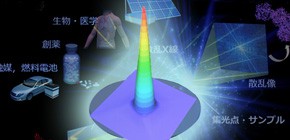
Ultrahigh precision focusing of XFEL radiation achieved with mirrors of nanometre accuracy
Under the leadership of YUMOTO Hirokatsu , Researcher, OHASHI Haruhiko , Associate Chief Researcher, TONO Kensuke , Associate Senior Researcher (all of Japan Synchrotron Radiation Research Institute), YAMAUCHI Kazuto , Professor, Graduate School of Engineering, Osaka University, MIMURA Hidekazu , Associate Professor, Department of Precision Engineering, The Graduate School of Engineering, The University of Tokyo, YABASHI Makina , Group Director, Beam Line Development Team, XFEL Research and Development Division, SPring-8 Center, Riken, and OHOMORI Hitoshi , Chief Fellow, Advanced Science Institute, Riken, a group of researchers has developed 420-mm-long mirrors possessing atomically controlled precise surfaces of nanometre accuracy at the X-ray Free Electron Laser (XFEL) facility, SPring-8 Angstrom Compact Free Electron Laser (SACLA). By employing two such mirrors, the group succeeded in enhancing the flux density of a focused XFEL beam 40,000-fold higher than that of the unfocused beam. This technology promises to make possible microscopic research approaching the ultimate ångstrom resolution, thereby enabling technological advances, including advances in pathogenesis and development of new medicines.
Abstract
X-ray free-electron lasers produce intense femtosecond pulses that have applications in exploring new frontiers in science. The unique characteristics of X-ray free-electron laser radiation can be enhanced significantly using focusing optics. However, with such an optical device, even a slight deviation from the ideal design can lead to considerable errors in the focusing properties. Here, we present reflective optics comprising elliptically figured mirrors with nanometre accuracy to preserve a coherent wavefront, successfully focusing a 10 keV X-ray free-electron laser to the small area of 0.95 × 1.20 µm 2 . The near 100% efficiency of this arrangement allows an enormous 40,000-fold increase in the fluence to a power density of 6 × 10 17 W cm -2 . This achievement is directly applicable to the generation of a nanometre-size beam with an extreme power density of >1 × 10 22 W cm -2 , which will play a crucial role in the advance of microscopic research towards ultimate ångstrom resolution, as well as in the development of nonlinear optical sciences under extreme conditions.
参考図

Figure 1

Figure 2

Figure 3

Figure 4

Figure 5
To learn more about this research, please read the full research report entitled " Focusing of X-ray free-electron laser pulses with reflective optics " on this page at the Nature Photonics website.
Related link
